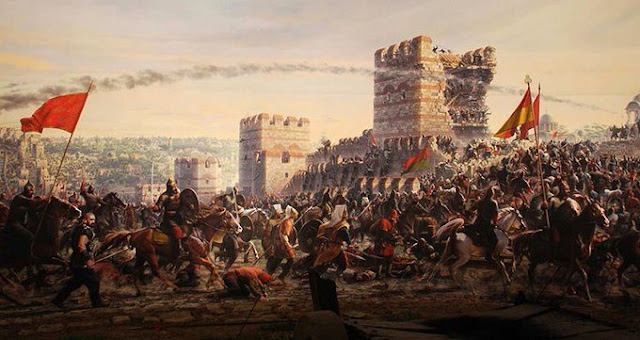Sultan Mehmet | The triumphant of Constantinople
“Either I conquer Constantinople or Constantinople conquers me”
~ Sultan Mehmet the Conqueror
When Sultan Mehmet conquered Constantinople on this day in 1453, it was a practice for conquering army of that time to carry out an unrestricted pillage for three days and places of worship became property of the conquering leader. But Mehmet the conqueror was exemplary.
After the conquest, Mehmet freed at once most of the noble ladies from the great families of Byzantium and gave them money so that they might redeem their families. Mehmet discovered that among the captives were Lucas Notaras the Megadux and nine Emperor's ministers. Loukas Notaras served as the last Megadux (commander-in-chief of the Byzantine navy) and the last mesazon (chief minister) of the Byzantine Empire. Mehmet himself redeemed all the ministers from their captors and received them graciously. He also released the Megadux.
Quite remarkable was the fact that the great cathedral of the Holy Apostles, the second largest and second most venerable church in the city, survived with its treasury intact. Mehmet at once sent guards to protect it after he conquered Constantinople. Sultan Mehmet offered George Scholarius the Patriarchate since the Unionist Patriarch, Gregory Mammas had fled from the city in 1451. He accepted.
In his role of Emperor, the Sultan received the new Patriarch in audience and handed to him the insignia of office, the robes the staff and the pectoral cross. While addressing the Patriarch, Sultan Mehmet said:
'Be Patriarch, with good fortune, and be assured of our friendship, keeping all the privileges that the Patriarchs before you enjoyed.'
The new Patriarch then mounted on a fine horse, the gift of the Sultan, and rode to the Church of the Holy Apostles, which was to be the Patriarchal Church. According to the ancient custom, he was enthroned by the Metropolitan of Heraclea.
Mehmet gave the Patriarch a written document promising him personal inviolability, exemption from paying taxes, complete security from deposition, complete freedom of movement and the right to transmit these privileges to his successors for evermore; similar privileges were to be enjoyed by the senior metropolitans and Church officials who formed the Holy Synod. A number of noble Byzantine families who had fled in recent years to the neighbouring provinces were persuaded to return. Five thousand families returned from Trcbizond and its neighbouring cities. These included not only the noble families but shop-keepers and artisans, and, in particular, masons to help in the construction of new houses, new bazaars, new palaces and new fortifications.
There were a number of districts in Constantinople where churches were untouched. The Christians continued to use them without interruption. When it was known that the Turks had broken through the walls, the officials in certain districts surrendered and opened the gates. The local officials were then sent under escort, with the keys of their townships, to the Sultan's camp where he accepted their submission and provided reliable police to ensure that their churches and houses were protected. The churches in Petrion where the fishermen had voluntarily opened the gates, in the neighbouring quarter of the Phanar and the churches in the whole area of Psamathia and Studium, by the Sea of Marmara where the defence had promptly offered its submission to the sailors of Hamza Bey's fleet were protected by the troops of Sultan Mehmet. Sultan Mehmet formed a milet, a self governing community within his empire under the authority of the Patriarch who would be responsible for their good behaviour before the Sultan.
Long before his death in 1481 Sultan Mehmet could look with pride on the new Constantinople, a city where new buildings were daily rising and where workshops and bazaars hummed with activity. Since the conquest, the population of Constantinople had increased fourfold; within a century it would number more than half a million. Sultan Mehmet created a new and splendid metropolis in which subjects of all creeds and races lived together in order, prosperity and peace.
Reference:
“The Fall of Constantinople 1453” by Steven Runciman



Comments
Post a Comment